Your cart is currently empty!
Delft Pottery Marks and How to Spot Them
Published:
Last Updated:
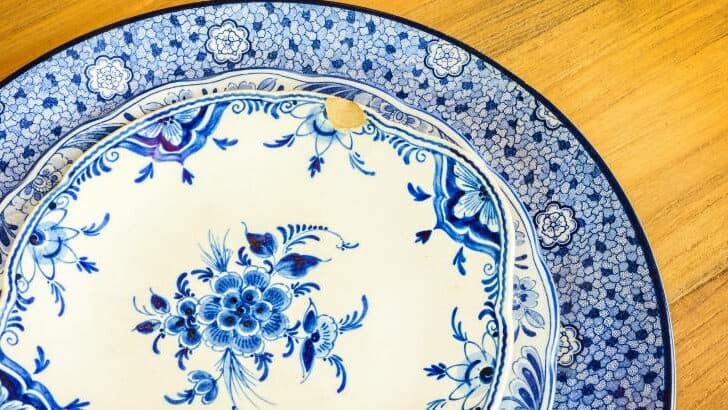
Affiliate Disclaimer
As an affiliate, we may earn a commission from qualifying purchases. We get commissions for purchases made through links on this website from Amazon and other third parties.
Pottery marks can be a good way of helping us to figure out where and when a piece of pottery was made, and who made it. Delft pottery marks are no exception and can be useful in enabling us to establish the history and value of a piece of Delftware.
The Delft pottery factories started to apply marks to the base of their pieces from the mid to late 17th century. And over the years the marks used by each of these factories changed as the factories came under new ownership.
As you can imagine there is a wide number of Delft pottery marks, which can be confusing. It can be helpful to know a bit about the history of Delft pottery marks if you want to use them to figure out the origins of an object.
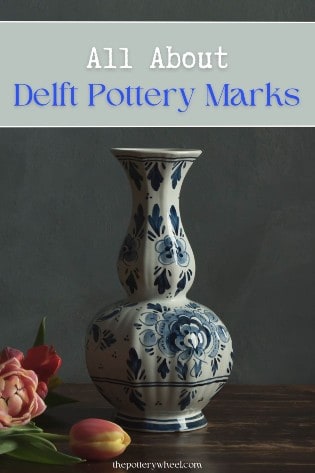
So, first, let’s look at the history of Delft pottery marks…
A Brief History of Delft Pottery Marks
A lot of the antique Delftware made by the original Delft factories was not marked. Only around a third of the pottery produced left the Delft factories with a mark on its base.
For example, De Porcelyne Fles (The Porcelain Bottle) was established in 1653. However, very few of the pieces that it produced before 1695 actually had a mark on the base(1).
The original owners who opened the factory did mark a few pieces. However, it wasn’t until the factory was taken over in 1697 by Johannes Knotter that the factory started to mark its pottery more regularly.
In fact, it’s thought that Johannes Knotter was the first owner of De Porceleyne Fles to use the icon of a small bottle as part of the factory’s mark. De Porceleyne Fles is also now known as The Royal Delft.
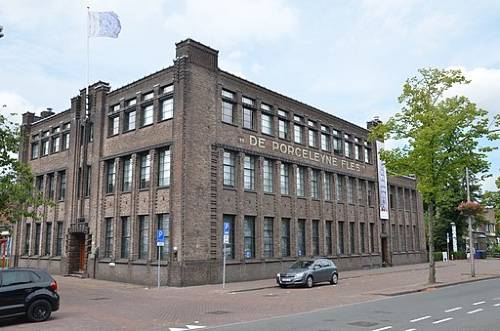
Steven Lek, CC BY-SA 4.0, via Wikimedia Commons
The factory continues to use the icon of a small bottle as part of its trademark today. We will look a little closer at this trademark later on. For now, let’s continue to consider the early history of Delft pottery marks…
Getting Organized
Justus Brouwer owned De Porceleyne Byl (The Porcelain Ax) between 1739-1775. He complained to the Delft City Council that other factories were copying the mark used by his factory.
The upshot of his complaint was that the use of pottery marks on Delftware became more formalized in 1764. During this year, the City Council made it law the pottery factories had to register their trademarks.
A book of brand marks was compiled which contained a drawing of the trademarks of twenty-three Delft pottery factories. It also contains a description and a picture of the signs that hung outside some of the factories.
Here is a sample of one of the entries into the brand book. It includes an illustration of the trademark used at the time by De Porceleyne Byl and a diagram of the sign that hung outside the factory.
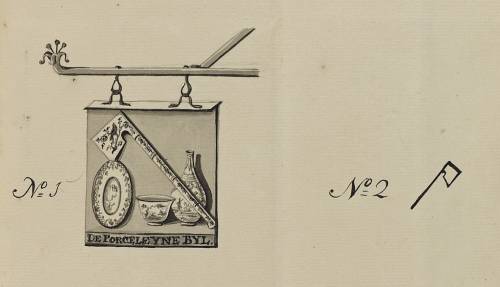
Modern Delft Pottery Marks
At the height of its popularity, there were over 30 factories in the city of Delft producing pottery. However, for a number of reasons during the 18th century, each of these factories closed down one by one. Today only one of the original pottery factories still remains in operation.
If you’d like to know more about the history of Delft pottery, you can check out my article on that subject here.
The factory that remains in operation today is De Porceleyne Fles mentioned above. The trademark used by De Porceleyne Fles has changed over the years that it has been in operation. These days the pottery mark it uses has a number of components.
The first element of the mark is a drawing of a small bottle. Underneath that are the initials JT which are combined together and look a bit like a backward F. These initials stand for the name Joost Thooft who bought the factory in 1876.
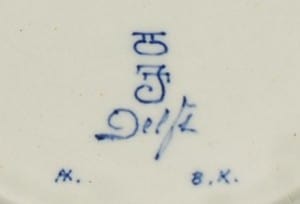
Beneath the initials is the word “Delft”. On the bottom, left is the painter’s initials, and on the bottom right-hand side is a code representing the year the object was made.
Other Contemporary Delft Pottery Marks
During the 20th century, a few other pottery factories in Delft have produced ceramics in a way that is faithful to many of the original production techniques.
Two of these factories are De Delftse Pauw (The Delft Peacock), and De Candelaer (The Candlestick). De Delftse Pauw was named after the original factory called De Paauw which closed in 1774. De Delftse Pauw was founded in 1954 and sadly closed down in 2020. However, De Candelaer, which opened in 1975, is still in operation.
Unlike De Porceleyne Fles, neither of these two factories was established with the original Delft potteries in the 17th and 18th centuries.
However, De Delftse Pauw made handmade and hand-painted ceramics using many of the same methods currently employed at The Royal Delft. And De Candelaer continues to produce high-quality Delft pottery using the same techniques.
If you’d like to know more about how Delft pottery is made and how the production process has changed over the years you can check out my article on that subject here.
Both De Delftse Pauw and De Candelaer have their own Delft pottery marks. Here is the mark that was used by De Delftse Pauw.
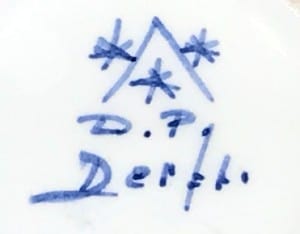
As mentioned above, over the years the identifiers used on Delft pottery have changed. If you are trying to spot antique Delft pottery using the marks on the base then it’s helpful to know about some of the older marking systems as well.
Now, let’s take a look at some of the marks made on antique Delft pottery too…
Antique Delft Pottery Marks
Being antique is often defined as any object that is older than 100 years old (source).
However, experts in Delft pottery tend to define antique Delft as being pottery that was produced between the late 17th century and the early 19th century (source).
As mentioned earlier on, most of the early pieces of Delft pottery were not marked. When they were marked, unlike the Delftware made today, the painter’s initials were not included in the markings.
Instead, the manufacturers sometimes used a simple drawing of an icon that represented the factory name. For example, De Drie Klokken (The Three Bells) factory used a drawing of three small bells.
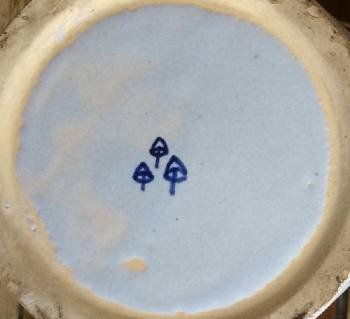
(CC BY NC SA 2.0)
Another good example of this was the factory mark used by De Klaauw (The Claw). When De Klaauw marked its pieces it would often use a drawing of a small claw on the underside of its pottery.
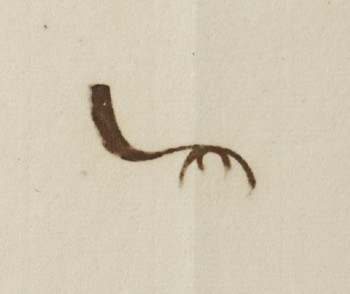
As an alternative, the Delft factories would sometimes use the initials of the factory owner to mark their pieces.
For example, the two polychrome plates below were made by De Porcelyene Fles and are marked on the underside with “K” for Johannes Knotter.
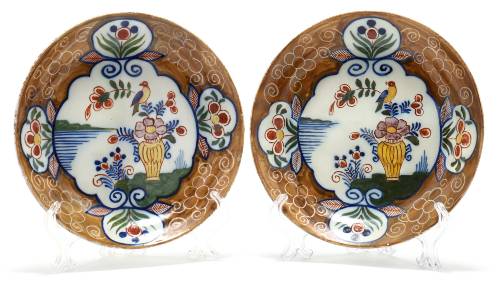
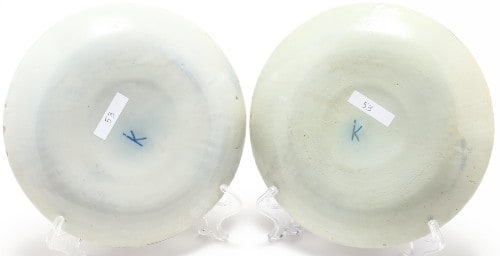
At other times, the figurative icon was combined with the initials of the factory owner to create a hybrid pottery mark.
For example, the image below is one of the marks used by De Porceleyne Fles, when it was owned by Jacobus Harlees between 1771 – 1786. It features a drawing of a small bottle plus the initials HL.
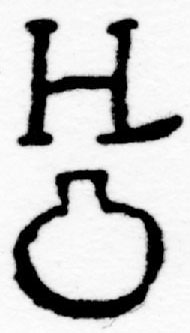
via Wikimedia Commons
(public domain)
Other numbers can also sometimes be found on the base of antique Delft pottery. However, very little is known about these additional numbers, and it’s generally assumed that they are to do with production processes used by the factories.
Examples of Delft Pottery Marks
Each of the different Delft factories has a number of different pottery marks that they used over the years. This is partly because when the factory was taken over by a new owner they would adapt the mark to reflect the new ownership.
The range of marks used is a bit mind-boggling and producing an exhaustive catalog would be a lifelong piece of work.
There are some famous publications that do aim to give a complete overview of the different pottery marks used by the Delft factories. One of these is a publication by Henry Harvard called Histoire De La Faience De Delft.
However, I thought it would be helpful to include some of the pottery marks used by the original Delft factories, to give you an overview of what to look out for.
I have listed the factories alphabetically in English for ease of reference, with the Dutch names in brackets after the English spelling.
The Claw (De Klaauw), 1661-1840

(CC BY NC SA 2.0)
The Double Jug (De Dubbelde Schenkkan), 1660-1770
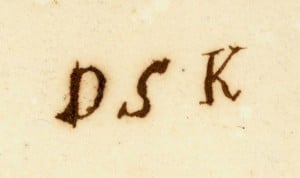
via Wikimedia Commons
The Fortune (‘t Fortuyn), 1661-1784
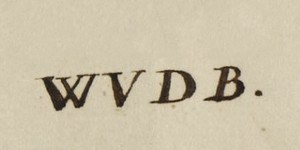
via Wikimedia Commons
The Gilded Boat (De Vergulde Boot), 1613-1770
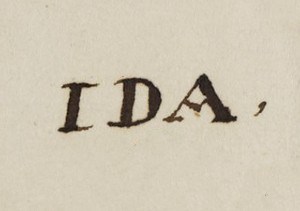
via Wikimedia Commons
The Gilded Flower Pot (De Vergulde Blompot),1616-1841
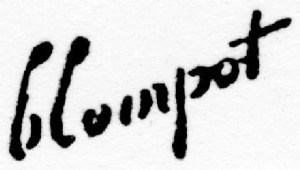
via Wikimedia Commons (public domain)
The Greek A (De Grieksche A), 1657-1818
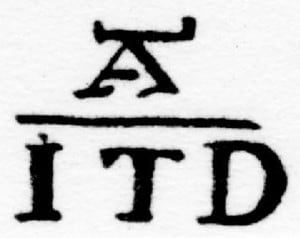
via Wikimedia Commons, (public domain)
The Metal Pot (De Metaale Pot),1670-1775

via Wikimedia Commons
The Young Moor’s Head (Het Jonge Moriaenshooft), 1690
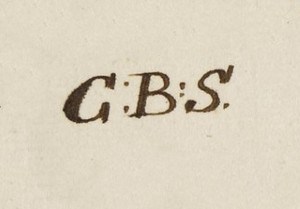
via Wikimedia Commons
The Old Moor’s Head (Het Oude Moriaenshooft), 1690
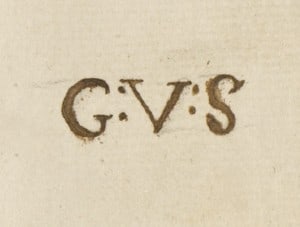
via Wikimedia Commons
The Peacock (De Paauw), 1651-1774
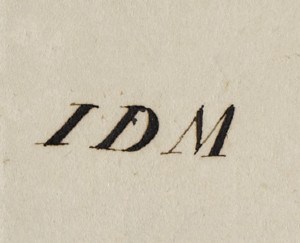
via Wikimedia Commons
The Porcelain Axe (De Porceleyne Byl), 1657-1803
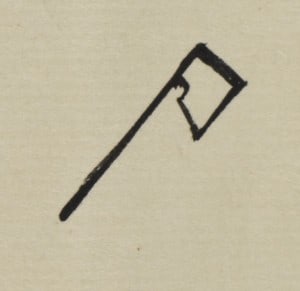
via Wikimedia Commons
The Porcelain Bottle (De Porceleyne Fles), 1653- to date
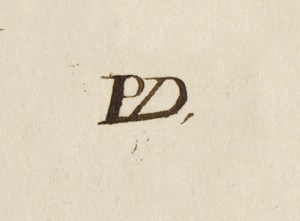
via Wikimedia Commons
The Porcelain Dish (De Porceleyne Schotel), 1598-1791
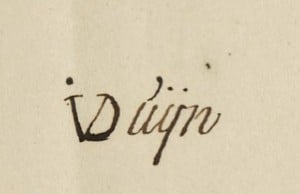
via Wikimedia Commons
The Porcelain Ewer / Jug (De Porceleyne Lampetkan),1609 – 1811
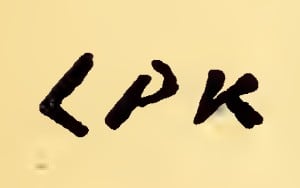
The Roman (De Romeyn), 1606-1774
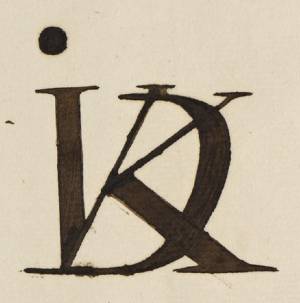
via Wikimedia Commons
The Rose (De Roos) est 1661-1858
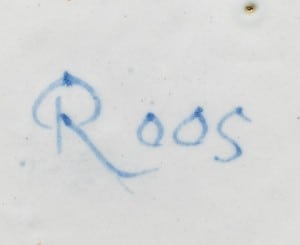
The Stag (‘t Hart), 1678 -1771
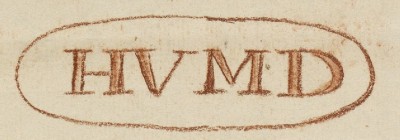
The Three Ash-Barrels (cinder tubs) (De Drie Astonne), 1655-1804

The Three Bells (De Drie Klokken), 1670-1841

via Wikimedia Commons
The Three Porcelain Bottles (De Drie Porceleyne Flessies), 1661-1777
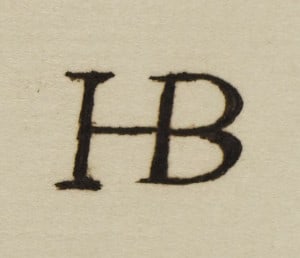
via Wikimedia Commons
The Two Little Ships (De Twee Scheepjes), 1619-1794
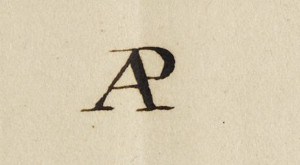
via Wikimedia Commons
The Two Wild Men (De Twee Wildemans), 1661-1788

via Wikimedia Commons
The White Star (De Witte Ster), 1660-1804
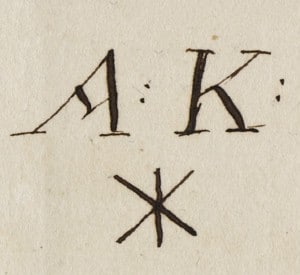
via Wikimedia Commons
How Delft Pottery Marks Were Applied
Most of the time Delft pottery marks were painted on the piece using a fine brush. Antique Delftware pottery marks were painted on with the cobalt oxide suspension that was used to decorate the pottery.
In later years Delft pottery has been decorated using blue underglaze and the pottery marks have been applied in underglaze too.
Sometimes the pottery marks were impressed lightly into the clay rather than being painted onto the surface(2). But most of the time the marks were painted on.
During the 17th and 18th centuries, 33 factories were in operation at one time or another in Delft. Some of these factories were bought out and taken over by other factories. And some simply went out of business and closed.
As mentioned earlier, out of the original factories, only De Porceleyne Fles remains in operation. And of the factories that did close, De Roos (The Rose) was the last close in 1858.
More Recent Delft Factories
Some of the newer factories that have sprung up since then, such as De Delftse Pauw and The Candelaer have remained faithful to the high levels of craftsmanship practiced by the original factories.
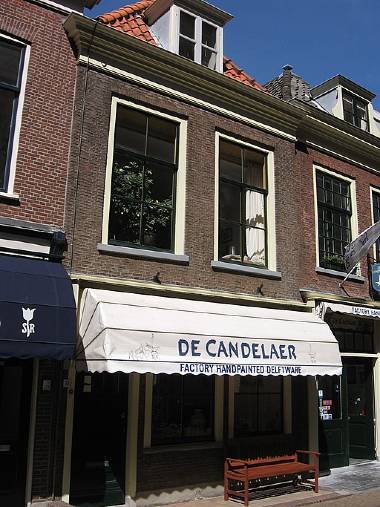
Michiel1972, CC BY-SA 3.0, via Wikimedia Commons
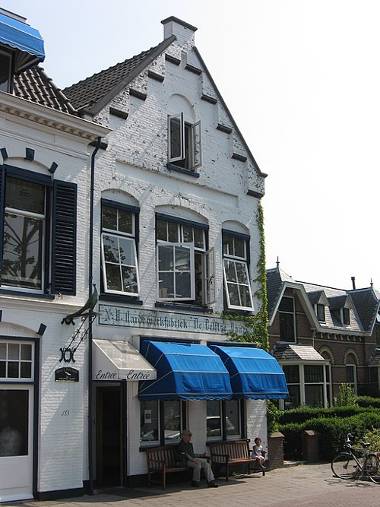
M.Minderhoud, CC BY-SA 3.0, via Wikimedia Commons
Nevertheless, Delft pottery produced in the second half of the 19th century or later is thought of as vintage rather than antique.
What is more, because of the forces of industrialization, and increased tourism, there has been a surge in cheaply produced ceramics made by other manufacturers in the style of Delft pottery.
This ceramic ware is often mass-produced, sometimes in China, and the decoration is printed on rather than hand-painted.
If you find a piece of pottery that has the traditional decoration of Delftware it can be tricky to know whether you were looking at something that is antique, vintage, modern, or mass-produced.
So, here are a few things to look out for when you are inspecting Delft pottery marks on the base of an object…
Antique Vs Modern Delft Pottery Marks
It’s important to point out that if a piece of ceramics has been made in Delft, then it is, by definition, Delft pottery. However, there is a difference between antique Delft, contemporary handmade and hand-painted Delft, and mass-produced ceramics that have been made in the Delft style.
As mentioned earlier on, the pottery marks on antique Delft tend to include either an icon representing the factory that made it, the initials of the factory owner, or a combination of the two.
However, when Joost Thooft took over De Porceleyne Fles in 1876, he introduced some changes to the way in which pottery marks were used on delftware.
Here are some of the changes that he made…
1) The Use of Painters Initials
When Joost Thooft bought De Porceleyne Fles it’s likely that there was only one painter working in the factory at that time. His name was Cornelis Tulk(3).
It’s thought that Tulk only signed a small number of the pieces that he painted. From 1878 onwards the factory started to employ more painters and gradually the artists started to add their signatures to the work.
2) The Addition of Date Codes
From 1879 De Porceleyne Fles started adding date codes to their Delftware.
3) Including the Word ‘Delft’
The word ‘Delft’ was also introduced at this time as being part of De Porcelain Fles trademark signature.
However, some of the mass-produced ceramics mentioned earlier on will use markings that include some of these elements. This is probably done to encourage the buyer to believe that they are purchasing hand-crafted items.
So how can you tell the less well-crafted items from genuine handmade Delftware? Let’s take a look at some of the features of the markings used on pottery that were probably not handcrafted.
Fake Delft Pottery Marks
If you have a piece of pottery with a marking that has been stamped onto the surface, then you can be sure that this is not antique Delftware.
Stamping pottery marks onto ceramics is something that began in the late 19th Century and took off in the first half of the 20th century. So, any stamped pieces will not be early Delftware.
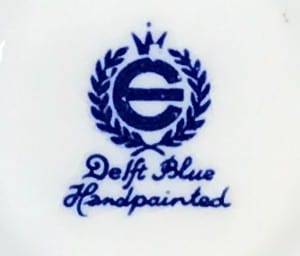
However, just because marks on the base appear to have been painted onto your pottery, this does not guarantee it is genuine handmade and hand-painted Delftware.
You might find that your pottery has the words ‘handmade’ or ‘hand-painted’ included in the marks. This is an indication that the object has been made in the style of Delft pottery rather than being genuine Delftware.
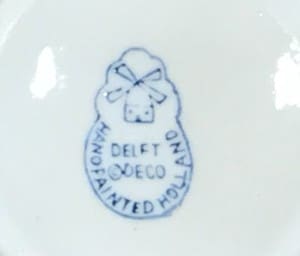
In an interesting video about De Candelaer, Steffan Delfos, the current owner of the factory talks about other things to look out for when trying to spot copies of Delft pottery.
He mentions that a lot of what he calls fake pieces also use the words ‘Delft blue’ or ‘Delfts’ or ‘Delftware’. And they may even use a small icon, something like a little crown, to give the piece a look of authenticity. The following mark is an example of this.
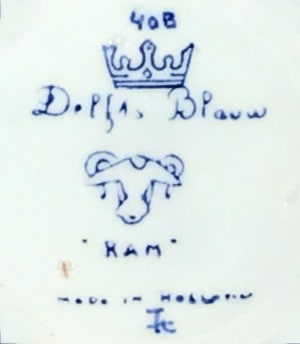
However, he goes on to say that pottery that has marks of this kind is rarely handmade. In fact, often the manufacturers will print on the decorations and then hand paint only a small detail such as the clouds.
This then gives them license to mark the object as hand-painted when in fact most of the decoration has been printed on.
The Use of Stickers
Generally speaking, if the pottery marks have been applied as a sticker then you are looking at pottery that has been made in the style of Delft rather than genuine Delftware.
Having said that, De Porceleyne Fles started to apply stickers to the base of their delftware in the 1970s. These are often paper stickers sometimes with blue lettering. Alternatively, they might be by gold foil stickers with either gold or silver writing on them(4). However, Stickers are used in combination with De Porceleyne Fles trademark.
It’s also possible you might find some Delft pottery with stickers alongside the pottery marks. These stickers may have been used by an antique dealer or a museum curator to categorize the item. As such, they can give us useful information about the history of the object.
Reproduction Delftware
There have been some significant manufacturers of reproduction Delft pottery. These manufacturers aimed to reproduce the style and look of antique Delft pottery.
One such manufacturer was the Frenchman Edme Samson (1810-1891). Samson opened up a factory in Montreuil, France with his son in 1864. The intention was to make reproduction ceramics. They made convincing reproductions of many different types of pottery from around the world. This included reproductions of antique Delft pottery.
Samson claimed that it was not his intention to create forgeries or to fool anyone. And the pieces produced in this factory when marked with the letter S to distinguish them from the originals.
Nevertheless, over the years some of these pieces have been mistaken for genuine Delft Ware, particularly when the letter S has been removed from the reproduction items (source).
Another famous manufacturer who made reproduction Delftware was Geo Martel. Martel bought a factory in Desvres, France in 1900. He was the designer and he manufactured high-quality reproductions of Old Delft earthenware (source).
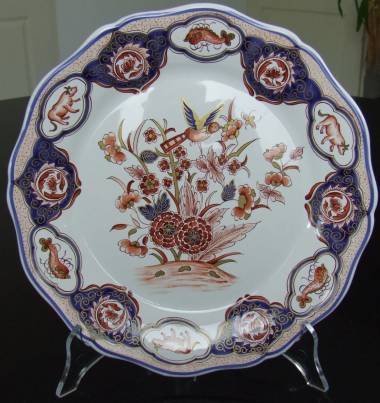
Image courtesy of DutchDelight.org
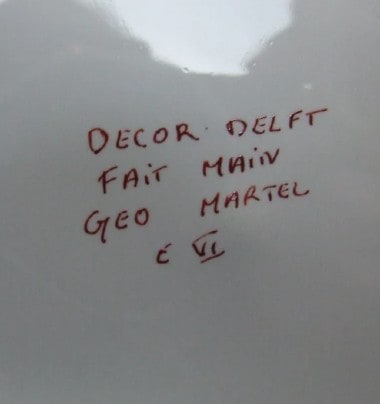
Image courtesy of DutchDelight.org
As with Samson, it was not Martel’s intention to deceive. And reproductions made by Martel are valuable in themselves. However, if you are trying to spot genuine delftware it is helpful to know that there are some convincing reproductions in circulation.
Final Thoughts
Delft pottery marks are a helpful way to identify and date your ceramics. However, not everything is known about the marks used on Delftware. So, whilst is helpful to have marks on your objects it is not the only way you can identify them. You can also use other features of Delft pottery in conjunction with the marks on its base to help you find its value and place in history.
References
1,2,3 & 4) Royal Delft, A Guide to De Porceleyne Fles. Erickson,R.



